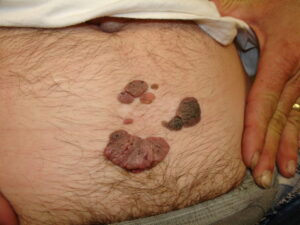Condyloma (genital warts) are a very common sexually transmitted disease occurring in 1% of the population. Many patients experience significant distress about having warts and are sometimes embarrassed to seek the help of a dermatologist. I stress with my patients affected by condylomas that they should not be ashamed as it is very common and treatable disease and they should not feel a stigma that they are “dirty” as condylomas can occur in almost anyone who has had sexual intercourse. Another common social issue encountered with the diagnosis of condylomas is that the patient attempts to pinpoint the sexual partner responsible for exposing them to the virus. It is next to impossible to ascertain the sexual partner who was the original source of the HPV. For instance, many women harbor the HPV virus but do not manifest any signs of warts. Men more commonly develop warts while many women are infected but have a subclinical response or their warts are found in less visible areas such as the vagina. I counsel my patients with warts to not play the “blame game” but to be aware that their sexual partner is being exposed and should be notified by the patient of this risk and take proper precautions. All women with or exposed to condylomas need to have a pap smear yearly as HPV is responsible for cervical cancer. They should also explore their options regarding Gardasil vaccination. Even when warts are not visible, a patient can still shed the HPV virus and be infectious. 90% of condylomas are usually caused by HPV 6 and 11, which are non-neoplastic (non cancer causing). There is a rare type of condyloma called Buschke-Lowenstein Condyloma which is a locally aggressive cancer caused by HPV 6. Essentially, Buschke-Lowenstein is a neglected condyloma that has become very large and is “eating into” the skin. 10% of condylomas are caused by HPV 16 and 18 which are neoplastic (cancer causing) and can cause a cancer called bowenoid papulosis (see blog entry on bowenoid papulosis). Treatment of condylomas involves liquid nitrogen destruction every two weeks until all warts are resolved. Aldara www.aldara.com is a prescription cream that can be effective on genital warts using it 3 times per week in the privacy of a patient’s home. In summary, genital warts are very common and patients should not hesitate to seek treatment as it is not a shameful condition but one that can have very serious health risks if left untreated.





